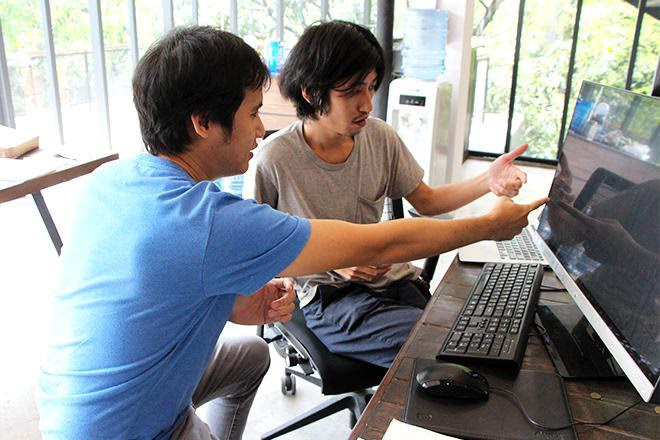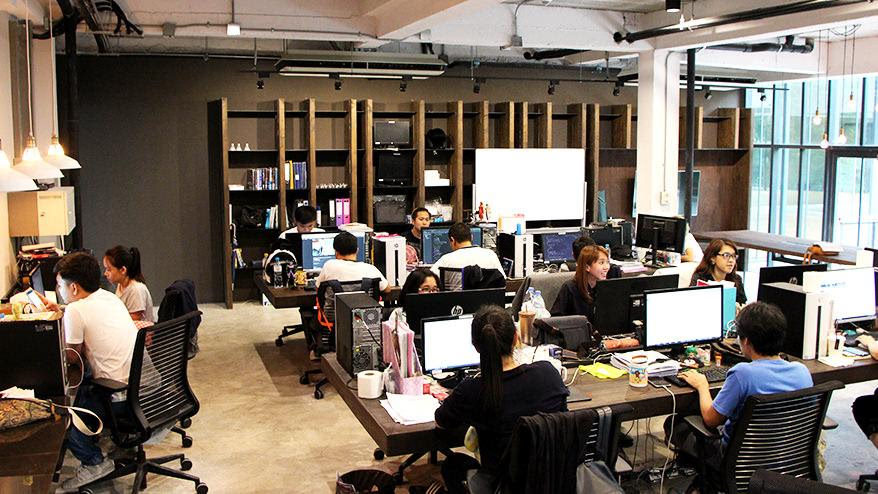こんにちは。モノサスタイランド(以下モノタイ)のディレクター川村です。
前回の仕事とくらしの記事ではモノタイの取締役、宮川の記事で日本のモノサス、モノタイとの関わり方、受注の流れの点を記事にてご紹介させていただましたが、今回はもうちょっと踏み込んで、実際の制作現場の雰囲気を、皆さんにお届けできればと思います。
始まりが肝心!タイ人コーダーと新しい案件を精査
モノタイで制作をする際の流れとしては、まず日本モノサスのセールスチームを介して、案件の相談がタイへやってきます。ほぼ毎日といっていいほど、東京、大阪の2拠点から案件の相談が来ますので、案件概要の確認や、支給されている資料の確認、仮に工数出しを行い、予定の期間内での対応が可能かどうか、などの精査を行っていきます。
精査を進める上で、国内モノサス営業とのやり取りをする窓口としては、日本人ディレクターが間に入ることになりますが、実際の工数見積もりの算出にはタイ人コーダーのリーダー、Tongを中心に、実際に案件担当となるコーダーにも入ってもらって、案件の対応可否やスケジューリングについて、事前に調整を行います。難易度の高い JavaScript の実装についての懸念や必要情報なども、実際の制作に入る前にできるかぎりヒアリングし事前に確認を行っています。

タイ人リーダーのTong(写真左)に案件の工数相談をする川村(写真右)
ライブ感あふれる制作現場はやはりディレクターが架け橋。あの手この手で仕様展開。
さて、実際に制作が始まる段階になると、まずディレクターは入稿物をもとに制作に必要な情報をコーダーとも共有を進めていきます。お客様から頂いた基本仕様書、サイトマップの情報などを Google Drive にまとめて、プロジェクトメンバーが閲覧できる環境を整えます。
資料の準備が整った段階で、通訳に各種資料の翻訳を依頼します。翻訳が完了した段階で、タイ人コーダーへ展開し、仕様の確認を行っていきます。
翻訳された仕様を確認してもらった後、プロジェクトメンバーには口頭で補足をしながら案件の基本仕様を説明する流れが一般的なフローとなります。
制作中の伝達は基本的に Skype を通して行われますが、必要となれば随時通訳を交えてコーダーと対話を重ね、制作を進める流れとなっています。フロントエンドの領域に関わる私たちの仕事では、JavaScript の動きなど、微妙なニュアンスをくみ取らなければ&伝えなければいけないケースも多いため、やはり対面での説明という工程は欠かせません。
時にはアニメーションの動きについての指示で「ニュルッと」「ふわっと」などの微妙な表現を、モニター指差し&ボディランゲージを交えながら説明することも。

ジェスチャーを交え、通訳のFon(中)を介してコーダーのPrem(右)に仕様を伝える赤嶺(左)
タイのディレクターは平均一人当たり約2~3件の案件を掛け持ちしていることが多い為、忙しい日はそれぞれのコーダーから確認、不明点の質問が飛び交い、ディレクターはメモ帳片手に、各時のデスクを駆け回る日もしばしば。
大変な時もありますが、ディレクター陣もタイ人と意思疎通を通して、目的の Webサイトを作り上げるという作業を楽しんでおります。
タイのディレクターも皆、なんだかんだ制作が好きなんですよね!
毎日が学びの場。3ヶ国語が飛び交う制作現場。
先述した通り、モノタイではディレクターとコーダー間でのやり取りは大きく、対面によるコニュニケーションと、Skype のチャット機能を使ってのテキストベースでのコミュニケーションの2種類に分かれます。
やり取りは基本的には英語、タイ語、日本語、3ヶ国語を使い分ける形で業務が進んでいます。
タイ人は日本人と比べ、英語に対する拒否反応が少ないというか、みんなそれなりに英語を理解できる傾向にあると感じています。街中にファラン(タイ語で西洋人を意味する)が溢れている環境からも感じ取れるように、バンコクの人たちは僕ら日本人よりも英語と接する機会も自然と多かったのだろうなと思います。私もタイに来てからは英語への恐怖心は大分克服できましたが、やはり英語だけでのコミュニケーションは困難なので、時にタイ語と織り交ぜてコミュニケーションをはかっています。
簡単なやりとりだけあれば、英語を通してディレクターからコーダーへ直接伝達できるものもあります。もちろん、タイ語を習得しているディレクターは、直接タイ語で指示出しをする場面もあります。
数の多い資料、仕様の細かなニュアンスを正確に、素早く伝えるために、通訳の存在もかかせません。現在モノタイには Fon(フォン)、Waan(ワーン)という通訳が在籍し、2名体制で通訳・翻訳業務を進めています。
そして、時にタイ語の先生でもあります。日本語で説明したものを直後にタイ語に翻訳してくれるのを、ウンウンこういうタイ語を使うのね、と日本人が聞いて学習する場面も多いのです。

通訳のFon(中)を介し、コーダーMong(右)にスマホの実機を見ながら動きの説明をする町山(左)
通訳が間に入ってやり取りを行う場合、認識のズレが少なく、間違いが発生しない、という安心感の反面、複数のプロジェクトが一斉に走っている場合には、翻訳の手が追いつかず、翻訳待ちのタイムラグが出てくるケースも出てきてしまいます。
ディレクターは通訳さんがスムーズに翻訳に入れるよう、翻訳資料の格納先や、Googleスプレッドシートに記載した情報をとりまとめ、Skype 上で情報の展開を進めていきます。
ここでも英語で展開可能なものは、直接英語にてコーダーに指示を下すディレクターもいます。
多い時には大小含め10近くのプロジェクトが進行するタイで、常に各案件の進行状況を確認し、即座に翻訳対応をしてくれるお二人には感謝。
モノタイが立ち上がり早3年、モノタイのコーダー側でも少しずつ変化が芽生え始めています。ふとした時に、コーダーのデスクを覗いて見ると、そこには日本語の練習帳が!

タイ人コーダーの日本語練習帳
モノタイはコーダーの採用時には、特に日本語のスキルを求めていません。
僕自身も、コミュニケーションの溝を埋める努力をするのは、やはりプロジェクトの橋渡し役となるディレクターだったり、仕組みを作る側の役目であり、コーダー側はあくまで、コーディングに専念するプロフェッショナルであれば良いのだ。という感覚を、誰に言われるまでもなく、感じていた節があります。そして、生産性を重要視した時には、実際にそうあるべきかもしれません。
それでも、コーダー達が自発的に、少しずつ日本語を理解しようと努力をしている現場を見ると、素直に嬉しく、微笑ましいです。お互いの文化を学びあってリスペクトし合いながら仕事をできる環境は、やはり今でも新鮮で貴重な体験かと思っています。
日本×タイ。ハイブリッドなチームが秘める可能性
いかがでしたでしょうか。簡単な説明とはなりましたが、モノタイの現場の雰囲気が少しでも伝われば嬉しいです。体制としても、ポテンシャルとしても、まだまだモノタイは発展途上の段階にあるかと感じています。
海外で制作をする上で、意思疎通や管理の上で抱える問題は常にあるものだと思います。ただ、それを乗り越えたときに、日本人、タイ人のハイブリッドなチームだからこそ、それがお互いの糧となり、文化を超えた絆が生まれるのだと感じています。
まだ詳細はお話しできませんが、トライリンガルな環境をベースに、新しい試みを計画中。と・・・今はここまで!次回の執筆まで秘密にしておきます!
日々試行錯誤の毎日ですが、これからチームでよりよいアウトプットができるよう、和気あいあいとやっていければと思います。
それではまた!

